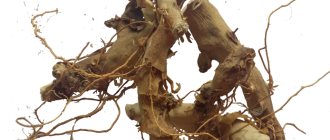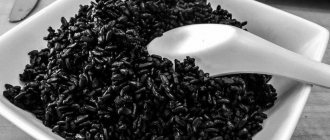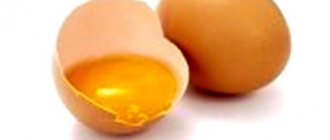What it looks like and where it grows
Witch hazel (Hamamelis) is a deciduous shrub of the Witch Hazel family, up to 12 m tall. It has graceful spreading branches with jagged dark green leaves on dense petioles. At the beginning of autumn, the crown of the plant turns yellow and falls off, and flowering begins at the same time. Numerous golden buds with long petals and purple stamens appear on the branches of witch hazel.
The flowers of the plant tolerate temperature drops down to -12 °C well.
The decorative period of the plant takes about two weeks. After this, witch hazel bears fruit - miniature egg-shaped nuts. It takes about six months to fully ripen; only at the beginning of summer the plant scatters black seeds, sometimes flying 10 m from the mother bush.
Witch hazel can be found in the Caucasus, East Asia and North America. For growth, the shrub chooses mainly light forests and river banks.
Plant care
While some species of these plants are native to our area, there are species that are less hardy in the colder parts of our country. Buy plants from your local garden center and grow them from spring to early fall in well-drained, moist, slightly acidic soil.
Water the shrub well and mulch with pine needles or chips to keep the soil moist and slightly acidic. In the spring, add a layer of compost and an acidifying fertilizer to keep the plant growing healthy.
Witch hazel does not require special care. Prune it to remove dead, diseased and damaged branches in the spring and to shape the shrub. Remove suckers from the base of the plant if they begin to crowd the branches.
Growing a witch nut can be a long process, so give it plenty of space. For young bushes, consider placing four stakes around the bush and wrapping burlap around them to protect the plant from winter winds. Remove the burlap early enough in late winter to enjoy the flowers.
Witch hazel is an easy-to-maintain shrub and requires little care once planted. Container-grown plants can be planted at any time, although they will do best if purchased and planted in the fall.
To reduce the chance of rhizome sucking, don't plant container-grown shrubs too deep and never bury the grafting union, which should be identified as a raised piece of stem just above the compost level.
Young plants may be damaged by hard frosts when first planted and should be covered.
Composition of witch hazel
The value of medicinal witch hazel is due to its rich composition. The green parts of the plant contain:
- phenolic substances;
- sugars and aromatic oils;
- vitamins of all main groups;
- tanning components;
- anthocyanins;
- flavonoids and flavones;
- carboxylic acids;
- glycosides;
- sesquiterpenes;
- essential oils;
- minerals.
When used correctly, witch hazel has a beneficial effect on the body and improves well-being. It is used not only in traditional medicine, but also in homeopathy. Plant-based products can be purchased in pharmacies.
Beneficial properties of witch hazel
Witch hazel has good strengthening properties. When used according to recipes, the plant:
- increases the elasticity of the walls of blood vessels;
- accelerates the healing process for wounds, cuts and abrasions;
- stops bleeding;
- has an analgesic and antiseptic effect;
- fights fungi and infections;
- helps with external and internal hemorrhoids;
- promotes rejuvenation of the body;
- prevents the development of oncological processes;
- eliminates swelling and removes toxins and waste from the body;
- has a strengthening effect and helps cope with diarrhea;
- regulates the production of subcutaneous sebum and eliminates dandruff;
- cleanses skin with acne, pimples and blackheads;
- helps cure dermatitis.
Witch hazel-based products are used for inflammatory diseases of the throat and oral cavity. Decoctions and infusions improve the condition of sore throat, periodontal disease and tonsillitis.
Methods of preparation and use
Traditional medicine suggests preparing aqueous preparations and products for external application based on witch hazel. In all types, the useful plant retains strong healing properties and quickly improves the condition of the body.
Witch hazel tincture
Witch hazel tincture is prepared mainly on a water basis. The recipe looks like this:
- Place a small spoonful of dry leaves and flowers of the plant into a thermos.
- Pour a glass of boiling water over the raw material.
- Close the thermos and leave to infuse for 15 minutes.
- Strain through cheesecloth to remove sediment.
The resulting tincture should be divided into three equal portions and taken during the day on an empty stomach. The product helps well with any inflammatory processes in the body and with weakened immunity.
Tincture of witch hazel flowers is included in pharmaceutical ointments based on the plant.
Decoction
Witch hazel decoction has a good effect on digestive disorders. It is prepared according to this scheme:
- The dry bark of the plant is crushed in an amount of 30 g.
- Pour the raw materials into an enamel bowl and add 1 liter of water.
- Bring to a boil on the stove and simmer over low heat for 15 minutes.
- Cool the product under the closed lid and filter to remove sediment.
We recommend reading: Beneficial properties of breadfruit and contraindications
You need to take the decoction in the amount of a glass three times a day in between meals. The drug normalizes digestion and relieves cramps in the intestines.
You can use a decoction of witch hazel bark externally to treat abrasions and cuts.
Tea
Tea made from witch hazel leaves has a beneficial effect on the body. It is recommended to use it for inflammatory processes in the oral cavity, for colds, and also for a tendency to diarrhea. Brew the drink according to the following algorithm:
- Place a small spoonful of crushed leaves into a ceramic teapot.
- Pour the raw material with 250 ml of hot water at a temperature of about 80 °C.
- Cover the kettle with a lid, wrap it in a towel and leave for ten minutes.
- Strain the drink through a strainer and pour into a cup.
The product can be consumed up to three times a day warm. The tea is also suitable for rinsing the mouth and throat.
You can't add sugar to witch hazel tea, but you can add a little honey.
Witch hazel extract
Typically, witch hazel extract (Witch Hazel extract, Witch hazel distillates; Extract of hamamelis; Extract of witch hazel; Hamamelis extract; Winterbloom) is a key component of cosmetics, therefore it is indicated in the first positions of the list of ingredients.
Witch hazel flower 26958
Properties of witch hazel extract used in cosmetics:
Cleansing . Witch hazel extract has strong astringent properties, regulates sebum secretion, tightens pores, refreshes the skin, and effectively relieves seborrhea.
Rejuvenating . Witch hazel extract tones the skin, softens it and eliminates flaking, improves complexion by enhancing blood microcirculation in the capillaries.
Anti-inflammatory . Witch hazel extract has very strong antibacterial and antifungal properties, is effective against any inflammatory processes, and is indispensable for acne, pustular rashes of any origin, traumatic skin lesions, and dermatitis.
Healing . Witch hazel extract has strong antioxidant properties, protects the skin from UV radiation, soothes and accelerates skin healing after sunburn, stimulates the healing of cracks and scratches on the skin.
Strengthening . Witch hazel extract strengthens vascular walls, stimulates the outflow of fluid, relieves puffiness and bruises under the eyes, rosacea.
Witch hazel extract is included in preparations for the treatment of varicose veins, hemorrhoids, psoriasis, and eczema. In folk medicine, witch hazel extract is used to treat bruises and contusions, bedsores and tumors from insect bites, and to reduce muscle pain after sports training.
The valuable properties of witch hazel bark and leaves have long been known to North American Indians, who used infusions of this plant to treat various inflammations. Modern research has discovered that witch hazel leaves have a high content of tannins, tannins, gallic acid, as well as glucose and essential oil. Thanks to these substances, witch hazel leaf extract perfectly strengthens the walls of blood vessels, regulates the functioning of the sebaceous and sweat glands, and has an exceptional antiseptic effect, which has found application in pharmaceuticals and cosmetology.
Cosmetics containing witch hazel extract:
- Emulsion for bruises and swelling around the eyes
- Cleansing milk, cleansing gel
- Toning, cleansing face masks
- Night softening cream for aging skin
- Peeling for deep exfoliation
- Cream, tanning oil
- Softening cream for skin care after peeling
- Lotion, tonic, gel wash for problem skin
- Day cream for oily and combination skin
- Anti-acne cream
- Cream to reduce rosacea
- Children's cosmetics for the care of inflamed skin
- Shampoos, balms for oily hair
- Cream for cracked heels
- Softening hand cream
- Aftershave
- Cosmetics for moisturizing and nourishing facial skin with witch hazel
Cosmetics with witch hazel extract are stored in the closet.
The use of cosmetics with witch hazel extract is undesirable:
- in case of individual intolerance to this plant
- in the first trimester of pregnancy
- in the immediate vicinity of wounds (witch hazel extract can cause irritation due to the alcohol component)
Witch hazel (witch hazel) is a lush shrub, reaching a height of 5-8 meters, with large leaves and bright, unusual flowers. North America is considered the homeland of witch hazel, but it can be found in the North Caucasus and East Asian region. Witch hazel received its name “Witch Hazel” for its unusual appearance and strange flowering pattern. In the fall, witch hazel delights the eye with bright orange, red and yellow leaves, then it drops them and blooms in the middle of winter, not afraid of snow and frost, and then only last year’s fruits ripen - seed pods with funny horns (they take 8 months to ripen).
Witch hazel seeds are collected in the fall to obtain the extract. 26656
Where do you get witch hazel extract for cosmetics?
The main supplier of witch hazel extract to the pharmaceutical and cosmetic markets is the USA.
To obtain witch hazel extract, leaves, shoots and thinly cut, dried bark of the bush are used. Witch hazel extract is obtained by steam distillation or alcohol extraction, then filtered to remove impurities. The resulting witch hazel extract will appear as a completely transparent liquid without color or odor.
Use in folk medicine
Instructions for use of witch hazel recommend using the plant for weakened blood vessels, digestive disorders and skin ailments. Traditional medicine offers several simple recipes.
For diarrhea
Witch hazel has good strengthening properties and helps with indigestion. For medicinal purposes the following decoction is prepared:
- Place about 15 g of dry crushed bark in an enamel pan.
- Pour 500 ml of boiling water over the raw material.
- Place the product on the stove and heat over low heat for 15 minutes.
- Strain through folded cheesecloth.
The product is consumed 250 ml three times a day in between meals. Witch hazel has a mild effect and stops diarrhea without harming the functioning of the intestines as a whole.
For external hemorrhoids
A decoction of witch hazel relieves pain from hemorrhoids and promotes their resorption. The remedy is made as follows:
- Pour a small spoonful of plant bark, previously ground into powder, into a small container.
- Pour the raw material into a glass of hot liquid.
- Simmer the solution in a water bath for a quarter of an hour.
- Cool until warm and strain.
Moisten a clean cloth or cotton pad in the resulting product and apply it to the anus overnight. The procedures are carried out every evening until the condition improves.
For nosebleeds
Witch hazel stops bleeding well and strengthens the walls of small vessels. Traditional medicine advises using this remedy:
- A small spoonful of dried plant flowers is poured into an enamel pan.
- Steam the plant material with 200 ml of hot water.
- Boil on the stove over low heat for two minutes.
- Cool the preparation and filter through gauze.
Take witch hazel decoction for nosebleeds twice a day, 100 ml in the morning and evening. Use the product on an empty stomach.
For sore throat and tonsillitis
The anti-inflammatory properties of witch hazel help combat bacterial infections in the throat and mouth. To eliminate pathogenic microorganisms, prepare the following tincture:
- Grind dried flowers and leaves of the plant in equal quantities of 10 g.
- Pour 500 ml of fresh boiling water over the raw material.
- Cover the container with a lid, wrap it up and leave to infuse for 15 minutes.
- Strain to separate the sediment.
You need to drink 80 ml of the tincture three times a day on an empty stomach or a couple of hours after meals.
For sore throat, tincture of witch hazel leaves and flowers is heated before use.
For varicose veins
The medicinal properties of witch hazel improve the tone of veins in varicose veins, eliminate pain and heaviness in the lower extremities. Traditional medicine recommends the following recipe:
- The dry bark of the plant is ground into powder using a coffee grinder.
- About 15 g of raw material is poured into 250 ml of hot liquid.
- The solution is poured into a thermos, covered with a lid and left for an hour.
- After the time has passed, pass the product through a gauze filter.
We recommend reading: Devil's Claw (Martinia fragrant): description, application, properties
Soak a cloth in the infusion and apply a compress to the sore spots for an hour. The procedure is carried out in the morning and evening every day; therapy must be continued until the condition improves.
Attention! In the initial stages of varicose veins, witch hazel helps remove characteristic venous nodes and restore attractiveness to the legs.
For periodontal disease
Healing witch hazel relieves bleeding gums due to periodontal disease, soothes pain and fights inflammation. For therapeutic purposes, prepare a decoction for rinsing:
- Pour 500 ml of fresh boiling water over a large spoon of witch hazel bark powder.
- Heat the solution over low heat for about 15 minutes.
- Remove from heat, cool to warm temperature and strain.
Rinse your mouth with the resulting drug undiluted up to six times a day. There is no need to swallow the medicine; after use it is spat out.
For venous insufficiency
You can use witch hazel for poor circulation and blood stagnation in the lower extremities. The recipe for preparing the healing remedy is as follows:
- Dry leaves of the plant are crushed in the amount of 5 g.
- Pour the raw material with 500 ml of hot water.
- Leave the solution under the lid and towels for 15 minutes to infuse.
- After the expiration date, pass through a gauze filter.
The product must be taken three times a day on an empty stomach, 100 ml.
It is allowed to add natural honey to the infusion of witch hazel leaves, but it is better to avoid sugar.
For dermatitis
The healing properties of witch hazel are beneficial for dermatitis and other inflammatory skin conditions. The following drug is prepared for treatment:
- Place dried plant flowers and crushed leaves into a glass jar.
- Fill the product to the top with high-quality vegetable oil, heated to 50 °C.
- Close the container and place it in a bright and warm place for a week.
- After time, pass the oil through cheesecloth to separate the sediment.
- Dilute 5 ml of the resulting witch hazel extract in 100 ml of good olive pomace.
The mixture is distributed over the affected areas of the skin and left for eight hours. To prevent the oil from staining your clothes, you can cover it with a cloth bandage on top.
Advice! To prepare the remedy, it is allowed to use purchased witch hazel extract, available in pharmacies.
Description of the plant
Regular forms are tender, while most hybrid varieties grow in more demanding conditions. A more heat-resistant variety, Hamamelis 'Diane', can be grown in hot countries.
Once grown, they require virtually no maintenance and are resistant to most pests and diseases. Witch hazel extract is commonly used for cosmetic and medicinal purposes.
While most varieties reach 3 – 6 meters in height at maturity, witch hazels can be reduced by pruning once they have finished flowering to allow the following year's buds to develop. Suckers that form around the base must be removed. As soon as new flower buds appear, the branches can be pruned and forced to bloom.
Bloom
This is an unusual plant in the world of shrubs. Depending on the species you grow, it will bloom in late fall, after all the leaves of the deciduous plants have fallen, or in late winter, before any other shrubs emerge.
Spider-like flowers are small but noticeable as they cover the bush and have no leaves to obstruct the view. The flowers range from yellow to almost red in color and are lightly fragrant. Fallen beautiful golden foliage decorates your garden. This large, woody shrub is shade tolerant, making it a good plant for forest conditions.
Collection and preparation
The leaves and flowers of the medicinal plant are harvested during the decorative period in September, and the bark is collected throughout the year. You can dry healthy raw materials in a warm, ventilated room naturally or using a dehydrator heated to 50 °C.
Witch hazel should be stored in glass containers, paper bags or fabric bags in a dark place with low humidity. From time to time, the raw materials should be stirred to prevent mold.
Witch hazel leaves, flowers and bark retain valuable properties throughout the year.











